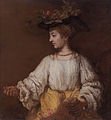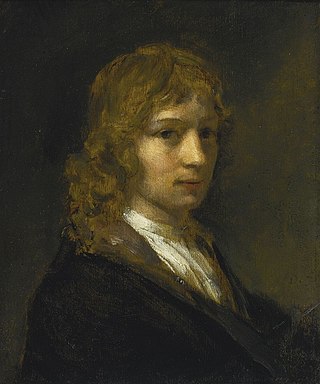
Willem Drost was a Dutch Golden Age painter and printmaker of history paintings and portraits.

GovertTeuniszoon Flinck was a Dutch painter of the Dutch Golden Age.

Saskia van Uylenburgh was the wife of painter Rembrandt van Rijn. In the course of her life, she was his model for some of his paintings, drawings and etchings. She was the daughter of Rombertus Uylenburg, the mayor as well as the justice of the Court of Friesland.

Rembrandt Harmenszoon van Rijn, usually simply known as Rembrandt, was a Dutch Golden Age painter, printmaker, and draughtsman. An innovative and prolific master in three media, he is generally considered one of the greatest visual artists in the history of art. It is estimated Rembrandt produced a total of about three hundred paintings, three hundred etchings, and two thousand drawings.

Jacob Adriaensz Backer was a Dutch Golden Age painter. He produced about 140 paintings in twenty years, including portraits, religious subjects, and mythological paintings. In his style, he was influenced by Wybrand de Geest, Rubens and Abraham Bloemaert. He is also noted for his drawings of male and female nudes.
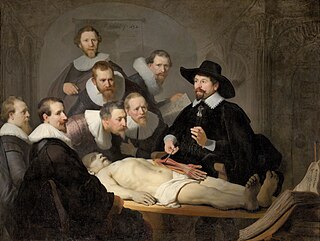
Hendrick Gerritszoon van Uylenburgh was an influential Dutch Golden Age art dealer who helped launch the careers of Rembrandt, Govert Flinck, Ferdinand Bol and other painters.

Titus van Rijn was the fourth and only surviving child of Rembrandt Harmenszoon van Rijn and Saskia van Uylenburgh. Titus is best known as a figure or model in his father's paintings and studies but also because of a legal case as preferential heir.
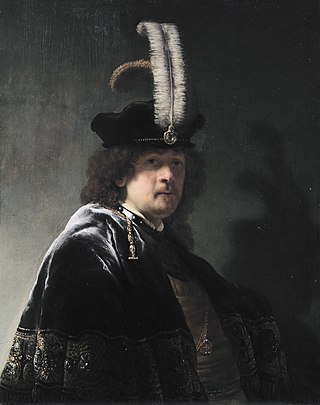
Self-portrait wearing a white feathered bonnet is an oil painting attributed to the Dutch painter Rembrandt. It is signed and dated 1635. It was traditionally regarded as a Rembrandt self-portrait until 1968, when it was rejected on stylistic grounds in the Rembrandt catalogue raisonné by Horst Gerson. In 2013, art historian Ernst van de Wetering re-attributed the painting as an original Rembrandt. It is one of over 40 painted self-portraits by Rembrandt.

A Polish Nobleman is a 1637 painting by Rembrandt depicting a man in a costume of Polish szlachta (nobility). The identity of the subject of the painting is unclear, and has given rise to several different interpretations. The view that the figure's dress is clearly Polish is not universally held and it may have been a self-portrait.

Portrait of Jan Six is a 1654 oil-on-canvas painting by the Dutch painter Rembrandt van Rijn. Having been handed down many generations, via the direct descendants of the portrait's subject, Jan Six, the work remains in the Six Collection in Amsterdam.
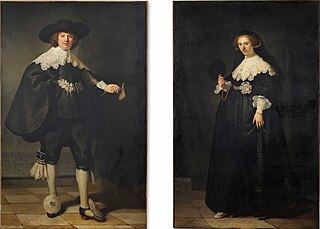
The pendant portraits of Maerten Soolmans and Oopjen Coppit are a pair of full-length wedding portraits by Rembrandt. They were painted on the occasion of the marriage of Maerten Soolmans and Oopjen Coppit in 1634. Formerly owned by the Rothschild family, they became jointly owned by the Louvre Museum and the Rijksmuseum in 2015 after both museums managed to contribute half of the purchase price of €160 million, a record for works by Rembrandt.

The Rape of Ganymede is an oil painting of 1635 by the Dutch Golden Age painter Rembrandt, depicting the myth of Ganymede. It is in the collection of the Gemäldegalerie Alte Meister in Dresden.
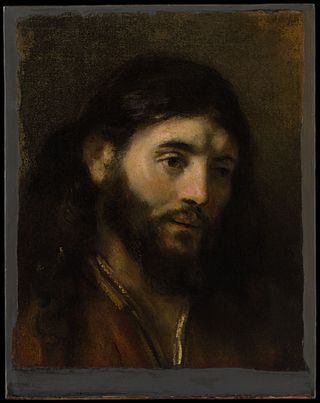
Head of Christ is a 1650s painting by Rembrandt's workshop. It shows Christ with a beard and long dark hair. It is in the collection of the Metropolitan Museum of Art.

Portrait of an Old Woman is a c. 1640 portrait painting painted in the style of Jacob Adriaensz. Backer. It shows an old woman with folded hands. It is in the collection of the Metropolitan Museum of Art.

Oval Portrait of a Woman is a 1633 portrait painting painted by Rembrandt. It shows a woman with a millstone collar and diadem cap. It is in the collection of the Metropolitan Museum of Art.

Portrait of a Young Woman with a Fan is a 1633 portrait painting by Rembrandt. It shows a woman holding a fan, pendant to Portrait of a Man Rising from His Chair. It is in the collection of the Metropolitan Museum of Art.

Portrait of a Woman Wearing a Gold Chain is a 1634 portrait painted by Rembrandt. It shows a smiling woman with a triple lace collar. It is in the collection of the Museum of Fine Arts, Boston.
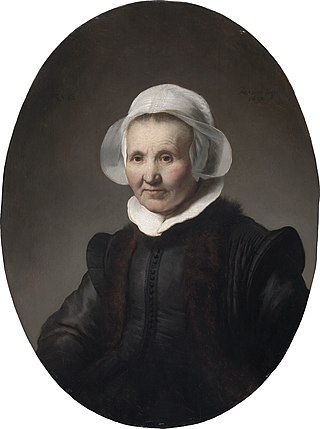
Portrait of a 62-year-old Woman, possibly Aeltje Pietersdr Uylenburgh is a 1632 portrait painting painted by Rembrandt. It is an oil on panel in oval format depicting an elderly woman with a small and sober millstone collar. It is in the collection of the Museum of Fine Arts, Boston.

Portrait of Petronella Buys (1610–1670) is a 1635 portrait painting painted by Rembrandt. It shows a young woman with a very large and impressive millstone collar. It is in a private collection.

David and Jonathan is a painting by the Dutch painter Rembrandt, made in 1642, now in the collection of the Hermitage Museum in Saint Petersburg, Russia. Painted on oak, it is one of the works, together with the Hellenistic sculpture acquired in 1850, The Venus de Taurida, with which the Hermitage began their collection in 1882.





